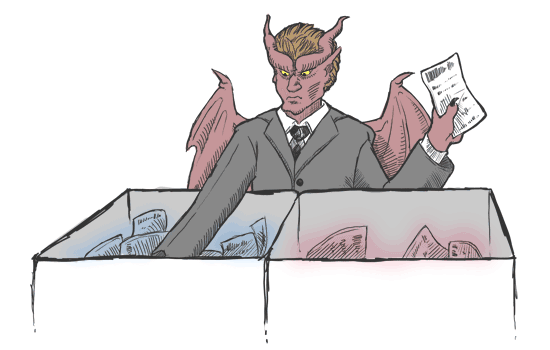Value Investing Strategy (Strategy Overview)
Momentum Investing Strategy (Strategy Overview)
Investing Demons
Maxwell’s Demon “works like a demon” operating a small doorway between two chambers of a vessel containing gas molecules. The demon’s goal is to sort the molecules by opening and closing the doorway such that fast-moving molecules concentrate in one chamber and slow-moving molecules concentrate in the other. The temperature difference between the two chambers could drive a heat engine and therefore perform some useful operation. Maxwell’s Demon thus serves as a useful thought experiment regarding whether one can “beat” nature with a very precise and efficient demon.
We borrow the Maxwell’s Demon construct in considering a financial markets expert, seeking to “beat the market” by concentrating high-return assets in one “chamber” and low-return assets in another. A real-life investing demon (especially an academically inclined one) may use four or five or ten “chambers” or “bins” to separate assets more finely according to expected returns. For simplicity, we stick to two bins, as depicted in the following figure. (Any similarity of the investing demon to any real financial markets commentator, advisor or asset manager, living or dead, is purely coincidental.)

An investing demon can choose from many macro and asset-specific conditions and characteristics as the basis for sorting assets, such as: asset class (for example, stocks or bonds or commodities or cash); macroeconomic conditions, company accounting/financial characteristics, technical trading indicators, investor sentiment measures and even temporal (for example, calendar-related) factors. Given all these ways to sort, it is probably more useful to think of the demon as sorting expected future returns rather than assets, with the returns associated (at least temporarily) with specific assets. The difference in returns between the two bins could drive a portfolio and thereby generate wealth. The demon can never rest because the future return for a given asset changes over time, necessitating continual re-sorting.
The questions implied by this investing demon construct are:
Do any of the conditions or characteristics from which an investing demon may choose (or combinations of same) reliably predict which assets will have high and low future returns, or at least higher and lower future returns relative to each other? If so, how big could the difference in returns between the two chambers be?
How much would the demon (or the demon’s subscriber/client) have to pay the market infrastructure to assemble and maintain a portfolio that effectively exploits the demon’s work?
How much would the demon’s subscriber/client have to pay the demon to sort assets and, if delegated, form and maintain portfolios?
The material that follows explores these questions. The intent is not to demonize investing commentators, advisors and asset managers, but simply to borrow a construct found useful elsewhere.
Physicists conclude that the energy consumed by any conceptual Maxwell’s Demon would exceed the useful energy available from the corresponding temperature difference between chambers. In fact, technologists can build only imperfect approximations of Maxwell’s Demon. Might an investing demon fare better?
Demons’ Drudgery – Demon’s Drayage – Demon’s Due
Demon’s Dilemma – Demon’s Defense – Pandemonium?

The Demon’s Drudgery
Is there evidence that supports belief in the inherent feasibility of the demon’s basic sorting task? The first step is to assess whether any demon could reliably discriminate between assets with high returns and assets with low returns over some actionable future interval.
There are many anecdotes of successful investing, but the story-tellers may be selectively sampling the extreme right (winner) tail of the distribution of investor experiences. A demon offering subscriber/client testimonials is unlikely to include complaints from those in the left (loser) tail.
There are also formal studies of investing outcomes for individual investors, with bottom-line conclusions such as:
…evidence indicates that individual investors on average significantly underperform the market.
…some individual investors/traders do consistently earn economically significant abnormal returns.
…it is very difficult for individual investors to beat the market.
…this evidence suggests that the average day trader breaks even…
…individual investors are systematic stock trading losers; institutions, systematic winners.
Over 80% of day traders lose money after transaction costs.
There are also a very large number (thousands) of formal and informal studies of historical data on doing the demon’s basic task by sorting assets and/or asset classes based on variables such as:
- Measures of performance of the overall economy (economic indicators)
- Financial performance or other accounting variables of the companies tied to the assets (market capitalization, book-to-market value or other fundamental variables)
- Historical price trend and/or other measures of trading behavior of the assets (momentum effect, volatility effects and other technical indicators)
- Surveyed or inferred sentiment/expectations of investors/management (buyback/issuance activity, futures activity, options activity, short selling activity and other sentiment indicators)
- Time of the year, month, week or day (calendar effects)
- Political conditions (political indicators)
There is considerable diversity in the methods used in these studies, making it difficult to infer the robustness of the results for any one study and to compare results across studies. Investing demons should therefore adopt a stance of considerable skepticism about stock-picking studies.
Moreover, many of the these studies are hypothetical to the extent that they do not realistically address all the market frictions (such as transaction fees and bid-ask spreads) inherent in portfolio management. More fundamentally, evidence of successful asset sorting in these studies may derive from sampling practices that measure luck within random fluctuations rather than persistent abnormal returns. In other words, available studies may be pervasively infected with biases, such as:
Survivorship or data availability bias: “The disaster ate my evidence (of a disaster).” An investing demon may, through ignorance, exclude some extremely bad returns from a sample.
Confirmation bias: From Paul Simon: “A man hears what he wants to hear, and disregards the rest.” For example, the demon may intentionally dismiss some disastrous returns as “incredible” outliers. Or the demon may ignore studies that cast doubt upon an embraced sorting strategy.
Look-ahead bias: “If I had traded based on this indicator over the past ten years, my portfolio would be up 1000%.” However, a demon using the indicator in real time would not have the data from the entire sample period to determine the buy-sell trading thresholds for the indicator. Well-known stock market anomalies may be much less reliable in rational practice than they appear in hindsight.
Data snooping bias: “I checked a thousand different indicators on my dataset, and found one that really works!” But, if there is randomness in the outcomes from a set of indicators/parameter settings, some will outperform by luck (with no assurance of continuing to do so). For example, just because one of a thousand coin-flippers “achieved” a high percentage of heads during one period does not mean the same coin-flipper will experience a high percentage of heads in a future period. For the investing demon, the past outperformance of an indicator as measured by an analysis substantially contaminated by data snooping bias is unlikely to persist at the historical level.
“Second-hand smoke” data snooping bias: “A famous guru [who tried a thousand indicators] says that this indicator is golden. I checked, and it is.” An investing demon copying another demon’s homework does not know how much data snooping bias comes with it.
Publishing bias (similar to second-hand data snooping bias): Uncounted instances of null (uninteresting) strategy test results on common datasets may be unsubmitted for publication or rejected for publication, thereby suppressing the detectable intensity of actual snooping.
Some research that seeks to correct the performance of characteristics/indicators/parameters for data snooping bias finds that:
This research on data snooping bias is a foundational threat to the belief of both investing demons and their subscribers/clients in the ability of demons to sort future asset returns accurately and reliably.
An inverse form of data snooping involves focusing on a single indicator but intensively searching for subperiods or subsamples (ranges of indicator values) that generate good results without understanding why the indicator works sometimes or in some ranges but not others. This mode of snooping incorporates luck not by iterating an indicator or parameter setting but by iterating subsets of data in search of one for which a given indicator works.
A second foundational threat to the value proposition of investing demons is evidence that financial asset returns have “wild” power law distributions rather than “tame” (such as normal) distributions. Yet many formal studies of financial markets determine statistical significance and therefore devise portfolios based on an assumption that the asset return distributions are tame. But the statistical anchors of mean, standard deviation and significance variables do not touch bottom in the indicated power law environments. The following sources address this wildness.
…noise generally swamps signal (true outperformance or underperformance) in financial markets…
For our demon, the wildness of financial asset return distributions means that just one or a few essentially unpredictable “outlier” asset returns will, based on average returns, make a hot bin cold or a cold bin hot. Said differently, temperature (average) may be a usefully informative measure for well-behaved gas molecules, but it is not for assets returns with wild distributions. This wildness seems like God’s game of keep-away from investing demons (and their subscribers/clients).
A third foundational threat to the value proposition of investing demons is evidence that financial markets adapt such that anomalies are transitory. Asset sorting strategies therefore do not work the same way twice. More abstractly, the act of exploiting characteristics of an inferred distribution of investing returns changes the characteristics. The following sources address market adaptation:
Returns for nine of 11 anomalies decline after publication…
The bottom line from these considerations is that investing demons appear to face stiff odds in accomplishing their basic task of dependably sorting financial assets based on future returns. The case against reliably substantial financial markets predictability may not be airtight, but any potential leaks seem small and hard to find. …[A]ny edges available are probably small, not highly reliable, linked to common sense (but not obviously) and eventually (soon?) lost to market adaptation.

The Demon’s Drayage
As noted above, many studies of financial asset returns do not address all the market frictions (such as trading fees and bid-ask spreads) inherent in implementing real portfolios. These frictions can be decisive for investing demon subscribers/clients seeking to extract wealth from the demon’s basic output of assets sorted according to future returns.
An individual acting as his own investing demon incurs costs for the computing power, analysis software and variable/indicator data needed to support asset sorting. The more complex the analysis and the more exclusive and therefore potentially informative the data, the higher these “search” costs. An individual delegating this basic sorting task to some other investing demon bears these costs as part of the demon’s due (next section).
An individual acting as his own portfolio manager incurs:
- Broker fees when buying “hot” assets and selling “cold” ones according to an investing demon’s sorts. In general, the smaller the portfolio (in dollars), the greater the percentage impact of these transaction fees.
- Asset liquidity costs (bid-ask spreads). The difference between bid and ask represents the opposing desires of buyers wanting a bargain and sellers wanting a premium, resulting in different distributions of prices available to buyers (from sellers) and to sellers (from buyers).
If the investing demon re-sorts hot and cold assets frequently, transaction fees and liquidity costs accumulate rapidly. A diligent demon takes these trading frictions into account explicitly by sorting on net rather than gross future asset returns based on clear trading assumptions. An individual delegating portfolio management to an investing demon bears these frictions indirectly as portfolio balance debits. Research often (but not universally) indicates that:
Infrequent trading and lower-risk holdings have been key to relative outperformance…
…a high level of trading activity usually underperforms.
Accurately incorporating realistic trading frictions into backtests, especially over the long term, is very difficult, because these frictions vary considerably over time.
Other trading frictions may also come into play depending on broker rules (for example, account balance requirements) and sorting strategy implementation approach (for example, stock borrowing costs for short sellers). Impact of trading, wherein the process of position accumulation or liquidation itself moves the asset price, may come into play for big players and especially illiquid assets.
An individual delegating portfolio management to an investing demon bears additional non-trading operational costs such as investment company reporting, compliance and marketing as portfolio balance debits.
A more subtle drag on portfolio performance relative to investing demon sorting returns derives from reconciling capital availability with opportunity availability. A chosen asset sorting strategy may at some times locate many “hot” assets (more than can reasonably be addressed with a limited amount of capital) and at other times no “hot” assets (forcing capital to go idle).

The Demon’s Due
Above and beyond reimbursement for trading frictions and other operational costs (if they manage client funds), investing demons require payment for the insight they offer in sorting financial assets based on future returns.
Media that proffer investing advice want subscription fees or eyeballs on advertisements. Research indicates that:
…”neither journalists nor their informants can systematically and accurately predict stock prices.”
Academics studying financial markets want employment (and tenure) and funding of their studies. Research indicates that:
…professional economists lose to simple models in forecasting stock market returns.
Expert equity analysts want employment by brokers and asset managers. Research indicates that:
…lead underwriter sell recommendations may be the only analyst calls worth tracking.
Newsletter sellers want subscription fees. Research indicates that:
Financial advisors want advisory fees, either as a percentage of account balance or a fixed fee. Research indicates that:
Mutual fund managers and hedge fund managers want management fees, normally as a percentage of account balance. Research indicates that:
…this review of mutual fund studies makes low-cost, broad market exchange traded funds sound good.

The Demon’s Dilemma
What’s an investing demon, who must earn a living, to do?
Many investing demons appeal to rationality using historical data and statistics, but these demons often incorporate sampling/analysis biases and an assumption of tamely distributed returns (see THE DEMON’S DRUDGERY above). Some demons appeal to greed by fostering belief that the rewards from investing, with their proprietary advice, are very large and reliable. Other demons appeal to fear by arguing that, without their proprietary advice, investors stand to lose capital in the face of looming disasters. Do any or all of these approaches work to attract and retain subscribers/clients?
Research, such as the following, suggests that investing demons can effectively exploit individual investor naivete and lack of self-confidence:
There is, further, research that indicates investing demons can survive and thrive via naive appeals to fear/greed and emphasis on entertainment/controversy (interesting stories) rather than scientific rigor, as follows:
…it seems that nature to a significant degree favors diversity over survival of the fittest.
Andrew Lo observed that: “…if one tortures a dataset long enough, it will confess to anything!” Investing demons may well be able to survive by torturing confessions from historical data and offering the confessions to potential clients as proof of buried treasure (marked on their proprietary maps).

The Demon’s Defense
In association with assertions of high returns and low risk, investing demons may engage in active defense with respect to any public missteps, such as the following (as encountered in the course of testing a large sample of public forecasts for the U.S. stock market):
10. You took my statement out of context, leaving out all the obfuscating elaboration, conditional clauses, counterpoints, big-picture equivocations and past statements. Your judgment is unfair.
9. I was close enough. You should give me credit.
8. I will be right eventually; I just don’t know when. (Or: I was right all along, but my timing was off.)
7. I may be wrong on some little things, but I’m dead right on all the big ones. The big ones far outweigh the little ones.
6. I provide risk assessments based on historical tendencies, not forecasts. You should not call it wrong. The low probability scenario happened; it was just bad luck.
5. My public statements may be sometimes wrong, but I am 100% right in my private newsletter. You have to pay for truly valuable advice.
4. Since I am rich and famous, I must be smart. Since I am smart, I must be right. Quid est demonstrandum. No need to check up on me any more.
3. If brokers weren’t so manipulative and investors so gullible, what I said would happen would have happened. You should give me credit for my elegant and compelling argument.
2. The Plunge Protection Team (or the President, or the Vice President and his cabal, or the Treasury Secretary, or the Federal Reserve, or the devious prime brokers, or the Japanese, or the Chinese, or the EU) intervened to prop up the market. You shouldn’t count that against me.
1. I was not wrong. You are an ass. [Many variations…some investing demons can be quite crude.]
0.5. You are just trying to make everyone else look bad so people will subscribe to your service.
0. What forecast? Let me tell you about a great new investment opportunity!

Pandemonium?
How can an investor sort the good demons from the bad ones? Lawyerly research suggests that:
For example:
Read the demon’s general disclaimer (often linked at the bottom of site pages). Does it say something like: “It should not be assumed that the trading recommendations or advice will be profitable or that they will not result in losses.” Do you believe the marketers or the lawyers?
Find the assumptions made about returns claimed by the demon:
Are claimed returns cherry-picked or do they comprise steady outperformance over a reasonably long period of time? (There is often not enough information to tell.)
Does past performance commence with a strong return burst (perhaps based on backtesting) and then moderate (perhaps in real trading)? Such a scenario may indicate picking a start date at the beginning of a non-repeating lucky streak. At the end of the streak, the luck is gone.
If the demon manages multiple services, are they all outperforming, or just the one being promoted? The latter case suggests the possibility of luck rather than skill in the promoted fund.
Are returns claimed by the demon from real trading or from a hypothetical backtest? Look for disclaiming statements such as: “Hypothetical performance results have many inherent limitations… One of the limitations is that they are generally prepared with the benefit of hindsight.” Exhaustive backtesting (data snooping) may well discover non-repeating lucky streaks rather than reliable patterns. Moreover, hypothetical trade timing may assume favorable entry and exit points that a real-life trader is very unlikely to achieve systematically.
Are returns based on trades signaled by a hypothetical, in-sample indicator threshold? In other words, does the demon present the history of an indicator and show that trading when the indicator crossed above or below certain thresholds would have generated fabulous returns? This approach incorporates look-ahead bias, because a trader using the indicator in real time would not have the data from the entire sample period to determine trading thresholds.
What are the assumptions about trading frictions? Look for disclaiming statements such as: “Performance reflects gross profit or loss and is exclusive of commissions, trading fees and subscription costs.” Assumptions about trading frictions (including about buy and sell prices with respect to the bid-ask spread) can have very large impacts on profitability for strategies that involve frequent trading and/or options. Also, in general, the less money one has to invest, the more trading frictions depress returns.
Are the returns claimed by the demon clearly tied to an amount of capital required to implement them, or are capital requirements hazy? If the frequency of a demon’s recommended trades is sometimes so slow that assumed position sizes leave a portfolio in cash, or so fast that the portfolio does not have the cash to exploit them all, then portfolio returns may be substantially lower than the demon’s per-trade statistics.
What are assumptions about the cost of the demon’s service as a drag on portfolio profitability?
Are the returns claimed by the demon for closed positions only, suggesting the possibility of a bow wave of underwater positions kept open and excluded from analysis?
How do the demon’s claims square with fundamental beliefs about the level of financial markets efficiency and wildness, and about human nature? Specifically:
Is there rigorous research that supports the existence of reliable returns of the magnitude claimed for the type of strategy employed by the demon (see THE DEMON’S DRUDGERY above)? More generally, is there credible research that supports the existence of reliable returns of the magnitude claimed for any investing strategy? In other words, does it seem too good to be true?
Why have market makers, hedge fund managers or other sophisticated investors not discovered and extinguished the asserted market opportunity?
If the demon can reliably generate very large returns, why is the demon bothering to sell and administer an advisory service rather than easily getting rich by investing?